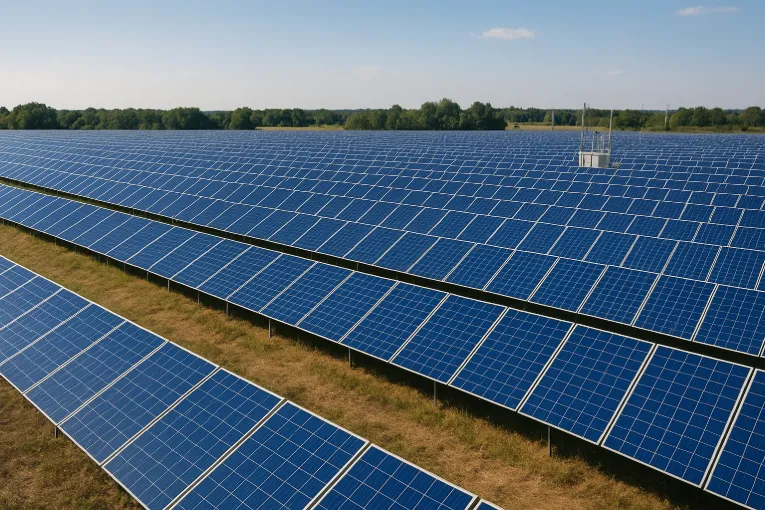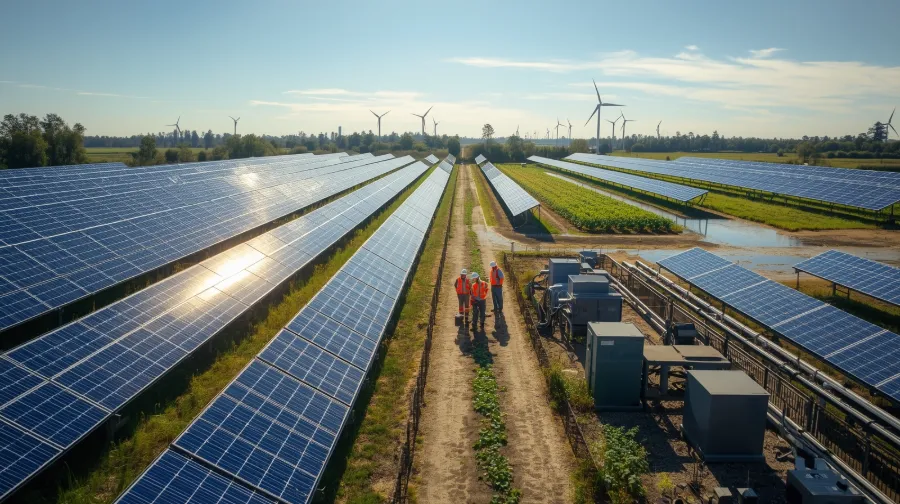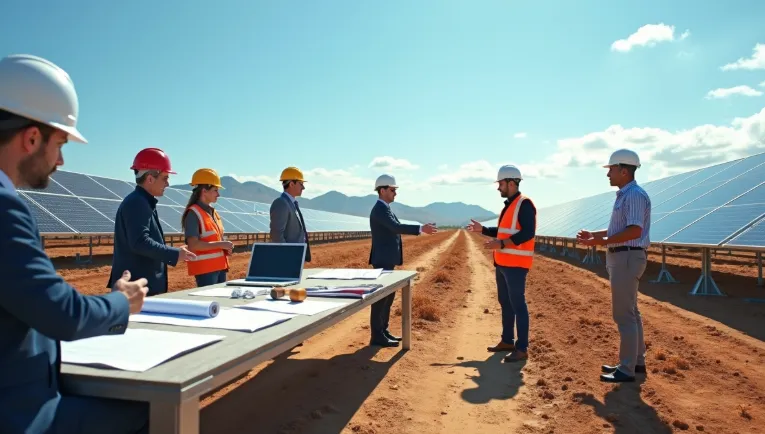A solar farm (also called a solar panel farm, solar park, or photovoltaic farm) is a large area of ground-mounted solar panels that capture sunlight and convert it into electricity.
Panels connect to inverters and transformers, converting DC into AC and feeding power into the grid or to local customers.
Solar farms range from large utility-scale projects that sell power to utilities to community solar farms shared by many subscribers.
Summary
A solar farm (solar panel farm or solar park) is a large ground-mounted array of photovoltaic panels that convert sunlight into electricity. Panels link to inverters and transformers to change DC into AC and feed power into the grid or to local customers.
Types range from utility-scale projects measured in megawatts to community solar farms shared by many subscribers. Costs depend on scale, land, equipment, and grid connection, and are influenced by PPAs and tax credits.
Benefits include clean energy, lower greenhouse gas emissions, and potential lease income; downsides include land use changes and visual impacts. Whether a solar farm is worth it depends on sunlight, grid access, local policy, and the financial deal for owners or communities.

What does a solar farm look like?
A solar farm typically features numerous rows of ground-mounted photovoltaic panels spread across open land, often arranged in long arrays with clear access lanes. Panels are mounted on fixed-tilt racking or on solar trackers that follow the sun; nearby, you will see inverters, transformers, and a small substation that convert and route the power generated.
Sites are fenced and have access roads, monitoring equipment, and space for maintenance; vegetation management and wildlife-friendly measures are often used. Utility-scale farms are measured in megawatts (MW) and typically need several acres per MW (commonly around 4–7 acres per MW depending on layout and tracker use).
Types of Solar Farms
There are several popular varieties of solar farms, each constructed for a different purpose and scale:
Utility-scale (large-scale solar)
These are large ground-mounted arrays, often ranging from tens to hundreds of megawatts (MW), that sell electricity to utilities or big buyers under power purchase agreements (PPAs). They are also called solar parks or solar panel farms and are designed for high power generation at a lower cost per unit.
Community solar farms
A community solar farm is a project where many households or businesses can join to use power from one solar array. People subscribe to or buy a share of the energy produced, which means they can benefit from renewable energy without needing to install panels on their own roofs.
Rooftop and distributed systems
Smaller photovoltaic systems on homes, offices, or carports are usually not called farms, but when many of these distributed systems are combined, they help meet local energy needs and reduce pressure on the main power grid.
Ground-mounted small and mid-scale farms
These solar farms provide electricity for local buildings, small grids, or commercial areas. They use the same photovoltaic panels and inverters as large projects but work on a smaller scale with a simpler business approach.
Tracker vs fixed-tilt systems
Some solar farms use fixed mounting systems that keep panels in one position, while others use solar trackers that move with the sun to produce more energy. Trackers can increase the amount of power generated per acre, but they also add extra cost and require more maintenance.
Floating PV and agrivoltaics
To conserve land, floating solar installations are on lakes, ponds, or reservoirs; in contrast, agrivoltaics puts solar panels and farming on the same piece of land, allowing crops or animals to share production space. These methods help reduce concerns about using farmland only for solar farms.
While photovoltaic panels, inverters, and other auxiliary equipment are used in all varieties of solar farms, their sizes, functions, and land uses vary. The best choice is determined by the project’s objectives, sunlight, land availability, and grid connection.
How Do Solar Farms Produce and Supply Electricity?
Direct current (DC) electricity is produced when sunlight strikes solar panels. After that, the DC power travels to inverters, which convert it to alternating current (AC), the common type of electricity used in grids, homes, and businesses.
To efficiently send the electricity to a substation or directly into the power grid, transformers then increase the voltage. Sophisticated control systems track energy production, continuously monitor performance, and automatically shut off systems to ensure safety.
Operators use this data to maintain and ensure the smooth operation of systems. The majority of solar farms sell their electricity in wholesale markets or deliver it under long-term power purchase agreements.
Some are coupled with battery storage, which enables energy to be stored and used without sunlight. To maintain a consistent and dependable supply of electricity, grid operators balance solar power output with stored energy or other power sources because it is dependent on the weather and time of day.

Benefits of Solar Farms
- Clean energy source: Solar farms generate electricity directly from sunlight, reducing air pollution and lowering reliance on fossil fuels.
- Low operating costs: Panels use minimal fuel and resources after installation, which lowers long-term expenses.
- Job creation and local income: Solar projects provide jobs during construction and maintenance, and landowners can earn steady income by leasing land.
- Access for everyone: Renewable energy is available to homeowners and renters without appropriate roofs thanks to community solar.
- Methods like floating solar and agriculturalvoltaics (farming + solar) help generate electricity without taking up valuable farmland.
- Better reliability: Solar farms have the ability to store energy and generate electricity even without sunlight when combined with batteries.
Challenges and Limitations of Solar Farms
- Intermittent power supply: Solar farms only generate electricity when the sun is shining. Cloudy days and nighttime reduce output, so backup systems or storage are often needed.
- Large land requirement: Utility-scale solar projects need hundreds to thousands of acres. This occasionally sparks discussion about turning agricultural land into energy rather than farming.
- While operating costs are low, building a solar farm requires major investment in panels, inverters, and infrastructure.
- Some regions lack strong transmission lines to handle the power from new solar farms, which can delay projects.
- Inadequate planning can have an impact on local landscapes, water runoff, and habitats when land is cleared for massive solar farms.
- Despite the fact that solar panels are usually silent and safe, some people are concerned about living close to solar farms, raising concerns about aesthetics, property value, and possible glare.
How High Is the Cost of Solar Farm Installation?
Installation Costs:
Building a solar farm typically costs $0.8 to $1.6 million per megawatt (MW) of capacity. A 1-MW farm typically takes 4–7 acres, so excluding land and grid connection fees, a project of this size typically costs about $1 million.
According to New Energy HBOWA, the initial setup for a solar farm usually ranges between $0.85 million and $1.2 million per MW. Additionally, they point out that projects typically yield steady returns with little ongoing cost after a payback period of 10 to 13 years.
The cost of land varies greatly; in rural areas, it might cost only a few thousand dollars per acre, but in urban areas or close to substations, it might cost much more.
Cost per acre
On average, a 1-acre solar farm can cost between tens of thousands to hundreds of thousands of dollars, depending on location, panel quality, and project size.
Ongoing Costs:
After installation, costs include land leases, insurance, operations, and equipment replacement. When compared to fossil fuel plants, these costs are comparatively low, which makes solar energy appealing over time.
Smaller community solar projects typically lack economies of scale, making them more expensive per watt than utility-scale farms.
Incentives and Add-Ons:
Overall expenses can be significantly decreased by government initiatives like renewable energy certificates and investment tax credits. Additionally, some farms install battery storage, which increases the initial cost of funds but increases the project’s value by storing energy for periods of high demand.
With land, grid access, and available incentives influencing final costs, a realistic planning estimate is roughly $1 million per MW.
What Role Do Solar Developers Play in Building a Solar Farm?
The businesses or experts that enable solar farms are known as solar developers. They plan how the farm will be connected to the power grid, secure land, and research sunlight resources. To guarantee that the project is approved, they also manage permits, environmental studies, and community involvement.
To ensure revenue, they simultaneously negotiate subscription contracts or power purchase agreements (PPAs) and set up financing.
Developers bring in engineering and construction teams to begin project construction after planning is finished. Others sell the farm to utilities or investors after construction, while others continue to oversee day-to-day management and repair.
To summarize it briefly, solar developers organize the legal, financial, and technical processes necessary to transform an idea into a fully functional solar farm.

Which Solar Farm Companies Lead the Industry?
NextEra Energy (U.S.), Enel Green Power (Italy), First Solar (U.S.), Light source BP (U.K.), Adani Green Energy (India), Iberdrola (Spain), and Reon Energy (Pakistan) are a few of the most well-known solar farm companies in the world.
These businesses are committed to increasing solar capacity across continents, investing in cutting-edge technologies, and scaling renewable power.
FAQs
What is the cost of a 1-acre solar farm?
A 1-acre solar farm typically costs around $200,000 to $250,000 to install, based on average utility-scale prices of about $1 million per MW and the rule of 4–7 acres per MW. The exact cost varies by land price, location, and grid connection fees.
Do solar farms make noise?
Solar panels themselves are silent. The only minor sound comes from inverters and transformers, which may produce a gentle background noise. With proper placement and enclosures, this sound is usually very low and not noticeable for nearby residents.
Are solar farms worth it?
Solar farms can be worthwhile if the location receives strong sunlight, has easy grid access, and benefits from good power purchase agreements or supportive incentives. They provide clean energy, cut greenhouse gas emissions, and offer steady lease income for landowners, though overall value depends on local policies and financial arrangements.
Can solar farms reduce fossil fuel use and gas emissions?
Yes, solar farms help reduce greenhouse gas emissions by generating renewable electricity instead of relying on fossil fuels. To ensure a stable power supply, they are often combined with battery storage or other flexible energy resources.
How long do solar farms last?
Solar farms are usually built to operate for 25 to 35 years. Over time, panels slowly lose a small share of efficiency each year, while parts like inverters may need replacement during the project’s lifespan.
Which solar farm in the USA is the biggest?
The largest solar project in the United States is the Gemini Solar + Storage Project in Clark County, Nevada. It has a solar capacity of 690 MW (AC) and pairs this with a 380 MW / 1,400 MWh battery storage system, making it the country’s biggest solar-plus-storage facility.
Commercial operations began in February 2024, and the project can supply enough electricity to meet roughly 10% of Nevada’s peak demand.
Which solar farm in the world is the biggest?
The Gonghe Talatan Solar Park, located in Gonghe County, Qinghai Province, China, is currently the largest solar farm in the world. It has a total capacity of 15.6 GW and covers about 610 square kilometers, roughly the size of Chicago.
As part of China’s major clean energy initiatives, it is expected to produce around 17,898 GWh of electricity annually, enough to power millions of homes.
References
The information in this article is based on insights from respected organizations in the energy field. We have reviewed content from the following sources to ensure accuracy and relevance:

